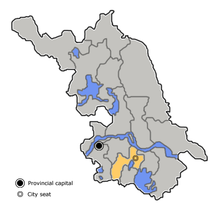- Changzhou dialect
-
Changzhou dialect 常州话 Pronunciation [sɑŋ.z̥ei.wu] Spoken in People's Republic of China Region Changzhou Native speakers 3.5 million (no date) Language family Language codes ISO 639-3 – Linguist List wuu-pil This page contains IPA phonetic symbols in Unicode. Without proper rendering support, you may see question marks, boxes, or other symbols instead of Unicode characters. Changzhou dialect (Simplified Chinese: 常州话; Traditional Chinese: 常州話; Pinyin: Chángzhōu huà) is a dialect of Wu, a Sino-Tibetan language, and belongs to the Taihu dialect group. It is spoken in the city of Changzhou and surrounding areas in Jiangsu province of China. It has many similarities with the Shanghainese and Suzhou dialect, but is largely not comprehensible between the speakers. It is not at all mutually intelligible with Mandarin, China's official language. It is much more closely related to the neighboring Wuxi dialect with which it is mostly mutually intelligible.
Phonetically, the Changzhou dialect makes use of a number of voiced or slack voiced initials [b̥ d̥ ɡ̊ v̥ z̥ d̥z̥ d̥ʑ̊] that not found in Mandarin as well as a larger number of vowel sounds [ɑ ɐ ɔ o æ ə ɨ ɨʷ ɛ ɤɯ e i u y].[1] The tone system also is of greater complexity, using 7 tones based on the classical tonal system. It also has a more complex tone sandhi than found in modern Chinese.
Contents
Geographic distribution
The Changzhou dialect is centered around the city of Changzhou and is spoken throughout the prefecture. It is notable as being one of the last places one hears Wu when traveling West before it gives way to the Southern Mandarin dialects, with the possible exception of the Gaochun dialect spoken in Southern Nanjing county.
Within the prefecture, there are also small but noticeable distinctions in pronunciation between the city center and the more rural surroundings which can be easily detected by native speakers. It is likely that as most residents have remained in the same village for many generations and have been locally educated these variations have managed to persist.
As one travels closer to Wuxi, the dialect begins to be closer to that spoken in neighboring Wuxi, the dialect of Wu that is most closely related to the Changzhou dialect. Speakers from the eastern Changzhou villages have little difficulty conversing fluently with those from the western end of Wuxi Prefecture.
Phonetics and phonology
Initials
Labial Dental Alveolar Palatal Velar Glottal Nasal m n ɲ ŋ Plosive voiceless p t k ʔ aspirated pʰ tʰ cʰ kʰ slack voice b̥ d̥ c ɡ̊ Affricate voiceless ts aspirated tsʰ slack voice d̥z̥ d̥ʑ̊ Fricative voiceless f s ɕ* h slack voice v̥ z̥ Approximant l ʎ ʟ ɦ Finals
open -i -u nasal -ng -r zero -ɨ -ʌ -ɔ -ɛ -æe -ei -ɯu -ɤɯ -æ̃ -õ -ʌŋ -ɛŋ -oŋ -ɚ i- -i -iʌ -iɔ -iɛ -iɯu -iɤɯ -ĩ -iõ -iʌŋ -iŋ -ioŋ u- -u -uʌ -uɔ -uɛ -uæe -uæ̃ -uõ -uʌŋ -uɛŋ ü- -y -yɛ -yiŋ Note2:
- The original tables[2] were compiled using a different system of transcription. Those letters have been replaced with the appropriate IPA phonetic notation. The order of the initials table has been made to match that of the article on the Shanghainese dialect.
Tones
Like a number of other Wu dialects, Changzhou dialect is considered to have seven tones. However, since the tone split dating from Middle Chinese still depends on the voicing of the initial consonant, these constitute just three phonemic tones. The seven tonic allophones were divided according to register by the Chinese-American linguist and Changzhou native Yuen Ren Chao. The high register includes the first, third, fourth and sixth tone with the second, fifth and seventh tone in the low register.[3]
Tone chart of Changzhou dialect[4][5] Number Tone name Tone contour Notes 1 陰平 yīn píng ˦ (44) mid-high 2 陽平 yáng píng ˩˧ (13) rising 3 上 shàng ˥ (55) high 4 陰去 yīn qù ˥˨˧ (523) dipping 5 陽去 yáng qù ˨˦ (24) mid-rising 6 陰入 yīn rù ˥ʔ (5) high entering 7 陽入 yáng rù ˨˧ʔ (23) rising entering, shorter than most other tones Tone sandhi
Sandhi in Wu dialects tends to be fairly complex as compared to Mandarin. While not nearly as complex as the Suzhou dialect of Wu, Changzhou dialect is no exception.
In the case of pairs of syllables have the stress on the second syllable, the only notable changes are the second syllable changing from (523) to (52) in the case of the fourth tone or from (13) to (11) with the second tone.[6]
Tone sandhi for Changzhou dialect[7] 1st 3rd 4th 6th 2nd 5th 7th first 33:33 55:32 55:32 55:3 33:33 55:32 55:3 third 53:22 53:22 53:22 53:2 53:22 53:22 53:2 fourth 55:55 53:22 55:55 55:5 55:55 55:55 55:5 sixth 5:55 5:55 5:42 5:5 5:55 5:42 5:5 second 11:33 11:55 11:33 11:5 11:33 11:33 1:3 fifth 32:23 32:23 35:32 32:23 32:13 35:32 32:23 seventh 23:33 23:33 23:42 23:3 23:33 23:32 23:3 Examples
Translation IPA Chinese character Changzhou [sɑŋ.z̥ei] 常州 Changzhou dialect [sɑŋ.z̥ei.wu] 常州话 I [ŋʌɯ] 我 You [ɲʒɛə] 你 Have you eaten? [tɕɛ.vɛi.vʌn] 喫飯朆(吃饭没) See also
Notes
References
Chao, Yuen Ren (1976). Aspects of Chinese Sociolinguistics: Essays. Palo Alto, CA: Stanford University Press. ISBN 978-0804709095.
External links
Chinese language(s) Major
subdivisionsNortheastern · Ji-Lu · Jiao-Liao · Zhongyuan · Southwestern · Lan-Yin · Lower Yangtze · Beijing · Dungan · Xuzhou · Luoyang · Jinan · Karamay · Nanking · Sichuanese · Kunming · Shenyang · Harbin · Qingdao · Guanzhong · Dalian · Weihai · Taiwanese Mandarin · Filipino-Mandarin · Malaysian Mandarin · Singaporean Mandarin · Chuan-puYueother MinDisputedUnclassifiedStandardized forms
(Ausbausprache)Phonology History Written Chinese OfficialHistorical scriptsOtherList of varieties of Chinese Categories:- Languages with Linglist but no iso3 codes
- Wu language
- Changzhou
Wikimedia Foundation. 2010.

